The Influence of Breed, Sex, Origin and Housing Conditions on Undesirable Behaviors in Ancient Dog Breeds
Abstract
Simple Summary
Abstract
1. Introduction
2. Materials and Methods
2.1. Data Collection
2.2. Statistical Analysis
3. Results
4. Discussion
5. Conclusions
Supplementary Materials
Author Contributions
Funding
Institutional Review Board Statement
Informed Consent Statement
Data Availability Statement
Conflicts of Interest
References
- Mason, G.J.; Rushen, J. Stereotypic Behaviour in Captive Animals: Fundamentals and Applications for Welfare, 2nd ed.; CAB International: Wallingford, UK, 2006. [Google Scholar]
- Hunthausen, W. Preventive behavioural medicine for dogs. In BSAVA Manual of Canine and Feline Behavioural Medicine, 2nd ed.; Horwitz, D.F., Mills, D.S., Eds.; Polish Edition; Wydawnictwo Galaktyka Sp. z o.o.: Łódź, Poland, 2016. [Google Scholar]
- Amat, M.; Manteca, X.; Mariotti, V.M.; Ruiz de la Torre, J.L.; Fatjo, J. Aggressive behavior in the English cocker spaniel. J. Vet. Behav. 2009, 4, 111–117. [Google Scholar] [CrossRef]
- Col, R.; Day, C.; Phillips, C.J.C. An epidemiological analysis of dog behavior problems presented to an Australian behavior clinic, with associated risk factors. J. Vet. Behav. 2016, 15, 1–11. [Google Scholar] [CrossRef]
- Kobelt, A.J.; Hemsworth, P.H.; Barnett, J.L.; Coleman, G.J.; Butler, K.L. The behaviour of Labrador retrievers in suburban backyards: The relationships between the backyard environment and dog behaviour. Appl. Anim. Behav. Sci. 2007, 106, 70–84. [Google Scholar] [CrossRef]
- Rosado, I.R.; da Silva, J.G.; de Freitas, D.M.; dos Reis, A.S.; Picelli, J.P.; Frange, S.E.; Alves, E.G.L.; Martin, I. Compulsive Disorder in Border Collie Bitch. Acta Sci. Vet. 2019, 47 (Suppl. 1), 452. [Google Scholar] [CrossRef]
- Wright, J.C.; Nesselrote, M.S. Classification of behaviour problems in dogs: Distributions of age, breed, sex and reproductive status. Appl. Anim. Behav. Sci. 1987, 19, 169–178. [Google Scholar] [CrossRef]
- Mason, G.J. Stereotypies: A critical review. Anim. Behav. 1991, 41, 1015–1037. [Google Scholar] [CrossRef]
- Frank, D. Repetitive behaviors in cats and dogs: Are they really a sign of obsessive-compulsive disorders (OCD)? Can. Vet. J. 2013, 54, 129–131. [Google Scholar] [PubMed]
- Luescher, U.A. Diagnosis and management of compulsive disorders in dogs and cats. Vet. Clin. N. Am. Small Anim. Pract. 2003, 33, 253–267. [Google Scholar] [CrossRef]
- Overall, K.L.; Dunham, A.E. Clinical features and outcome in dogs and cats with obsessive compulsive disorder: 126 cases (1989–2000). J. Am. Vet. Med. Assoc. 2002, 221, 1445–1452. [Google Scholar] [CrossRef]
- Mason, G.J.; Latham, N.R. Can’t stop, won’t stop: Is stereotypy a reliable animal welfare indicator? Anim. Welf. 2004, 13, S57–S69. [Google Scholar]
- Luescher, U.A.; McKeown, D.B.; Halip, J. Stereotypic or obsessive-compulsive disorders in dogs and cats. Vet. Clin. N. Am. Small Anim. Pract. 1991, 21, 401–413. [Google Scholar] [CrossRef]
- Mason, G.; Clubb, R.; Latham, N.; Vickery, S. Why and how should we use environmental enrichment to tackle stereotypic behavior? Appl. Anim. Behav. Sci. 2007, 102, 163–188. [Google Scholar] [CrossRef]
- Protopopova, A.; Hall, N.J.; Wynne, C.D.L. Association between increased behavioral persistence and stereotypy in the pet dog. Behav. Proc. 2014, 106, 77–81. [Google Scholar] [CrossRef] [PubMed]
- Tynes, V.V.; Sinn, L. Abnormal Repetitive Behaviors in Dogs and Cats: A Guide for Practitioners. Vet. Clin. N. Am. Small Anim. Pract. 2014, 44, 543–564. [Google Scholar] [CrossRef] [PubMed]
- Kobelt, A.J.; Hemsworth, P.H.; Barnett, J.L.; Coleman, G.J. A survey of dog ownership in suburban Australia-conditions and behaviour problems. Appl. Anim. Behav. Sci. 2003, 82, 137–148. [Google Scholar] [CrossRef]
- Meyer, I.; Forkman, B. Dog and owner characteristics affecting the dog-owner relationship. J. Vet. Behav. 2014, 9, 143–150. [Google Scholar] [CrossRef]
- Shouldice, V.L.; Edwards, A.; Serpell, J.A.; Niel, L.; Robinson, J.A. Expression of Behavioural Traits in Goldendoodles and Labradoodles. Animals 2019, 9, 1162. [Google Scholar] [CrossRef]
- Fatjo, J.; Amat, M.; Mariotti, V.M.; Ruiz de la Torre, J.L.; Manteca, X. Analysis of 1040 cases of canine aggression in a referral practice in Spain. J. Vet. Behav. 2007, 2, 158–165. [Google Scholar] [CrossRef]
- Stelow, L. Diagnosing Behavior Problems A Guide for Practitioners. Vet. Clin. N. Am. Small Anim. Pract. 2018, 48, 339–350. [Google Scholar] [CrossRef]
- Burn, C.C. A vicious cycle: A cross-sectional study of canine tail-chasing and human responses to it, using a free video-sharing website. PLoS ONE 2011, 6, e26553. [Google Scholar] [CrossRef]
- Mariti, C.; Gazzano, A.; Moore, J.L.; Baragli, P.; Chelli, L.; Sighieri, C. Perception of dogs’ stress by their owners. J. Vet. Behav. 2012, 7, 213–219. [Google Scholar] [CrossRef]
- Hall, N.J.; Protopopova, A.; Wynne, C.D.L. The role of environmental and owner-provided consequences in canine stereotypy and compulsive behavior. J. Vet. Behav. 2015, 10, 24–35. [Google Scholar] [CrossRef]
- Moon-Fanelli, A.A.; Dodman, N.H. Description and development of compulsive tail chasing in terriers and response to clomipramine treatment. J. Am. Vet. Med. Assoc. 1998, 212, 1252. [Google Scholar]
- Diesel, G.; Brodbelt, D.; Pfeiffer, D.U. Characteristics of relinquished dogs and their owners at 14 rehoming centers in the United Kingdom. J. Appl. Anim. Welf. Sci. 2010, 13, 15–30. [Google Scholar] [CrossRef] [PubMed]
- Salman, M.D.; Hutchison, J.; Ruch-Gallie, R.; Kogan, L.; New, J.C.; Kass, P.H.; Scarlett, J.M. Behavioral reasons for relinquishment of dogs and cats to 12 shelters. J. Appl. Anim. Welf. Sci. 2000, 3, 93–106. [Google Scholar] [CrossRef]
- Protopopova, A. Effects of sheltering on physiology, immune function, behavior, and the welfare of dogs. Phys. Behav. 2016, 159, 95–103. [Google Scholar] [CrossRef]
- Protopopova, A.; Gunter, L.M. Adoption and relinquishment interventions at the animal shelter: A review. Anim. Welf. 2017, 26, 35–48. [Google Scholar] [CrossRef]
- Taylor, K.D.; Mills, D.S. The effect of the kennel environment on canine welfare: A critical review of experimental studies. Anim. Welf. 2007, 16, 435–447. [Google Scholar]
- Parker, H.G.; Kim, L.V.; Sutter, N.B.; Carlson, S.; Lorentzen, T.D.; Malek, T.B.; Johnson, G.S.; DeFrance, H.B.; Ostrander, E.A.; Kruglyak, L. Genetic structure of the purebred domestic dog. Science 2004, 304, 1160–1164. [Google Scholar] [CrossRef] [PubMed]
- Coile, D.C. Encyclopedia of Dog Breeds, 3rd ed.; Barron’s Educational Series, Inc.: Hauppauge, NY, USA, 2015. [Google Scholar]
- Dodman, N.H.; Brown, D.C.; Serpell, J.A. Associations between owner personality and psychological status and the prevalence of canine behavior problems. PLoS ONE 2018, 13, e0192846. [Google Scholar] [CrossRef] [PubMed]
- Jakovcevic, A.; Elgier, A.M.; Mustaca, A.E.; Bentosela, M. Frustration Behaviors in Domestic Dogs. J. Appl. Anim. Welf. Sci. 2013, 16, 19–34. [Google Scholar] [CrossRef] [PubMed]
- TIBCO Statistica; v. 13.3.0; TIBCO Software Inc.: Palo Alto, CA, USA, 2017.
- Borchelt, P.L. Aggressive behavior of dogs kept as companion animals: Classification and influence of sex, reproductive status and breed. Appl. Anim. Ethol. 1983, 10, 45–61. [Google Scholar] [CrossRef]
- Duffy, D.; Hsu, Y.; Serpell, J.A. Breed differences in canine aggression. Appl. Anim. Behav. Sci. 2008, 114, 441–460. [Google Scholar] [CrossRef]
- Martınez, A.G.; Pernas, G.S.; Casalta, F.J.D.; Rey, L.S.; Palomino, L.F.D.C. Risk factors associated with behavioral problems in dogs. J. Vet. Behav. Clin. Appl. Res. 2011, 6, 225–231. [Google Scholar] [CrossRef]
- Podberscek, A.L.; Serpell, J.A. Environmental influences on the expression of aggressive behaviour in English Cocker Spaniels. Appl. Anim. Behav. Sci. 1997, 52, 215–227. [Google Scholar] [CrossRef]
- Amat, M.; Le Brech, S.; Camps, T.; Torrente, C.; Mariotti, V.M.; José, L.; Ruiz, J.L.; Manteca, X. Differences in serotonin levels between aggressive English cocker spaniels and aggressive dogs of other breeds. J. Vet. Behav. 2013, 8, 19–25. [Google Scholar] [CrossRef]
- Dodman, N.H.; Karlsson, E.K.; Moon-Fanelli, A.; Galdzicka, M.; Perloski, M.; Shuster, L.; Lindblad-Toh, K.; Ginns, E.I. A canine chromosome 7 locus confers compulsive disorder susceptibility. Molec. Psych. 2010, 15, 8–10. [Google Scholar] [CrossRef] [PubMed]
- Rigterink, A.; Houpt, K. Genetics of canine behavior: A review. World J Med Genet. 2014, 4, 46–57. [Google Scholar] [CrossRef]
- Yokoyama, J.S.; Hamilton, S.P. Genetics of Canine Behavioral disorders. In The Genetics of the Dog, 2nd ed.; Ostrander, E., Ruvinsky, A., Eds.; CABI: Wallingford, UK, 2012; pp. 275–320. [Google Scholar]
- Vermeire, S.; Audenaert, K.; De Meester, R.; Vandermeulen, E.; Waelbers, T.; De Spiegeleer, B.; Eersels, J.; Dobbeleir, A.; Peremans, K. Serotonin 2A receptor, serotonin transporter and dopamine transporter alterations in dogs with compulsive behaviour as a promising model for human obsessive-compulsive disorder. Psychiatry Res. 2012, 201, 78–87. [Google Scholar] [CrossRef]
- Jagoe, A.; Serpell, J. Owner characteristics and interactions, and the prevalence of canine behaviour problems. Appl. Anim. Behav. Sci. 1996, 47, 31–42. [Google Scholar] [CrossRef]
- Kim, Y.M.; Abd El-Aty, A.M.; Hwang, S.H.; Lee, J.H.; Lee, S.M. Risk Factors of Relinquishment Regarding Canine Behavior Problems in South Korea. Berl. Munch. Tierarztl. Wochenschr. 2009, 122, 1–7. [Google Scholar]
- Voith, V.L.; McCrave, E.A.; Marder, A.R.; Lung, N. Environmental and behavioural profiles of dogs with separation anxiety. In Proceedings of the First International Conference on Veterinary Behavioural Medicine, Birmingham, UK, 1–2 April 1997. [Google Scholar]
- Wells, D.L.; Hepper, P.G. Prevalence of behavior problems reported by owners of dogs purchased from an animal rescue shelter. Appl. Anim. Behav. Sci. 2000, 69, 55–65. [Google Scholar] [CrossRef]
- Podberscek, A.L.; Serpell, J.A. The English Cocker Spaniel: Preliminary findings on aggressive behaviour. Appl. Anim. Behav. Sci. 1996, 47, 75–89. [Google Scholar] [CrossRef]
- Dehasse, J. Le Chien Agressif; Polish Edition; Wydawnictwo Galaktyka: Łódź, Poland, 2006. [Google Scholar]
- Beerda, B.; Schilder, M.B.H.; Van Hooff, J.A.R.A.M.; De Vries, H.W.; Mol, J.A. Chronic Stress in Dogs Subjected to Social and Spatial Restriction. I. Behavioral Responses. Physiol. Behav. 1999, 66, 233–242. [Google Scholar] [CrossRef]
- Sueda, K.L.C.; Malamed, R. Canine aggression toward people: A guide for practitioners. Vet. Clin. N. Am. Small Anim. Pract. 2014, 44, 599–628. [Google Scholar] [CrossRef] [PubMed]
- Gácsi, M.; Vas, J.; Topál, J.; Miklósi, Á. Wolves do not join the dance: Sophisticated aggression control by adjusting to human social signals in dogs. Appl. Anim. Behav. Sci. 2013, 145, 109–122. [Google Scholar] [CrossRef]
- Amat, M.; Camps, T.; Le Brech, S.; Manteca, X. Separation anxiety in dogs: The implications of predictability and contextual fear for behavioural treatment. Anim. Welf. 2014, 23, 263–266. [Google Scholar] [CrossRef]
- Ballantyne, K. Separation, Confinement, or Noises: What Is Scaring That Dog? Vet. Clin. Small Anim. 2018, 48, 367–386. [Google Scholar] [CrossRef] [PubMed]
- Flannigan, G.; Dodman, N.H. Risk factors and behaviors associated with separation anxiety in dogs. J. Am. Vet. Med. Assoc. 2011, 219, 460–466. [Google Scholar] [CrossRef] [PubMed]
- Sherman, B.L. Separation anxiety in dogs. Compend. Contin. Educ. Pract. Vet. 2008, 30, 27–42. [Google Scholar]
- Sargisson, R. Canine separation anxiety: Strategies for treatment and management. Vet. Med. Res. Rep. 2014, 5, 143–151. [Google Scholar] [CrossRef] [PubMed][Green Version]
- Butler, R.; Elliffe, D.; Sargisson, R.J. The efficacy of systematic desensitization for treating the separation-related problem behaviour of domestic dogs. Appl. Anim. Behav. Sci. 2011, 129, 136–145. [Google Scholar] [CrossRef]
- Ogata, N.N. Separation anxiety in dogs: What progress has been made in our understanding of the most common behavioral problems in dogs? J. Vet. Behav. 2016, 16, 28–35. [Google Scholar] [CrossRef]
- Rehn, T.; Keeling, L.J. The effect of time left alone at home on dog welfare. Appl. Anim. Behav. Sci. 2011, 129, 129–135. [Google Scholar] [CrossRef]
- Horwitz, D.F. Separation-related problems in dogs and cats. In BSAVA Manual of Canine and Feline Behavioural Medicine, 2nd ed.; Horwitz, D.F., Mills, D.S., Eds.; Polish Edition; Wydawnictwo Galaktyka Sp. z o.o.: Łódź, Poland, 2016. [Google Scholar]
- Lindell, E. Management problems in dogs. In BSAVA Manual of Canine and Feline Behavioural Medicine, 2nd ed.; Horwitz, D.F., Mills, D.S., Eds.; Polish Edition; Wydawnictwo Galaktyka Sp. z o.o.: Łódź, Poland, 2016. [Google Scholar]
- Denham, H.D.C.; Bradshaw, J.W.S.; Rooney, N.J. Repetitive behaviour in kennelled domestic dog: Stereotypical or not? Physiol. Behav. 2014, 128, 288–294. [Google Scholar] [CrossRef]
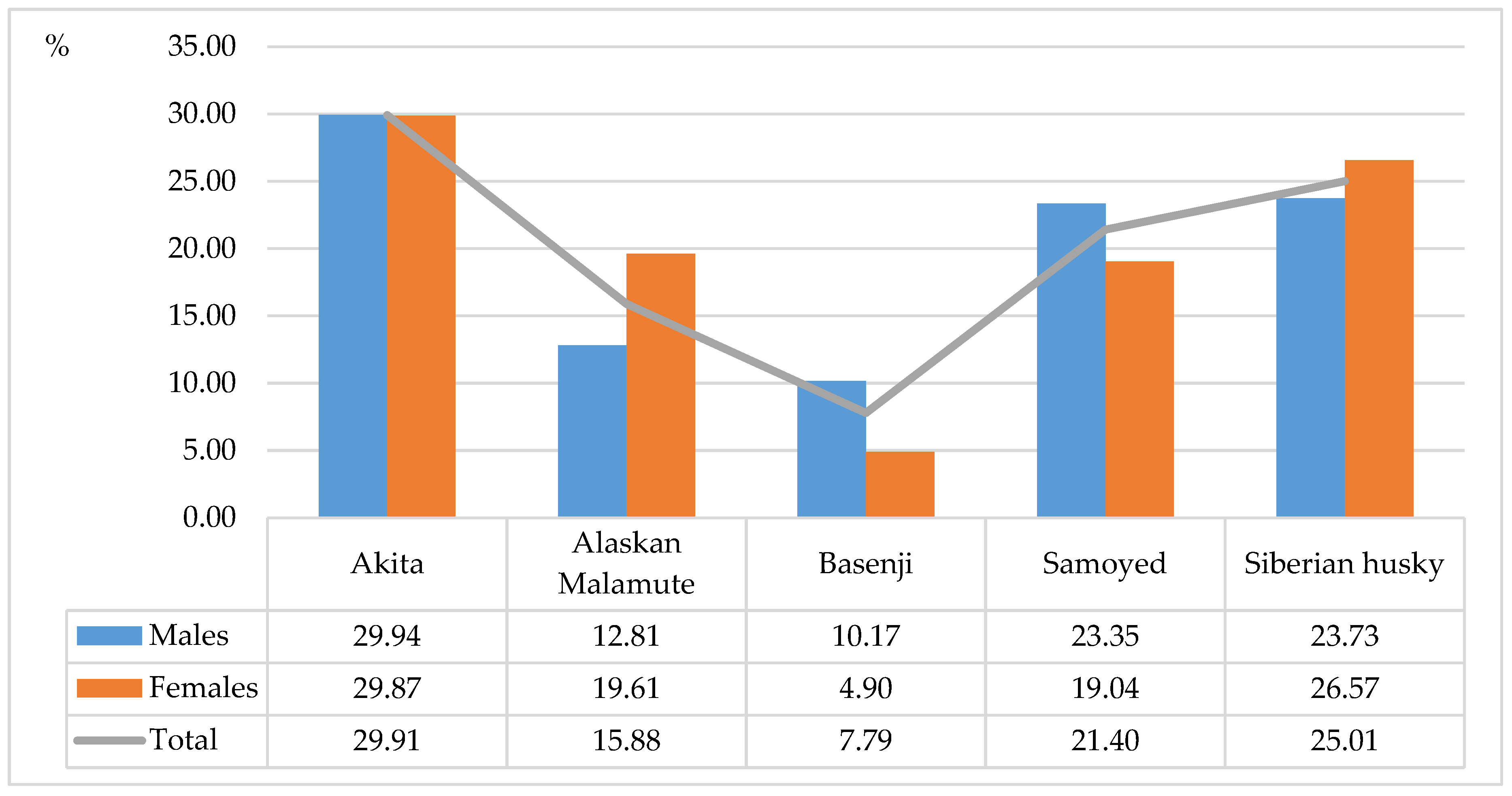

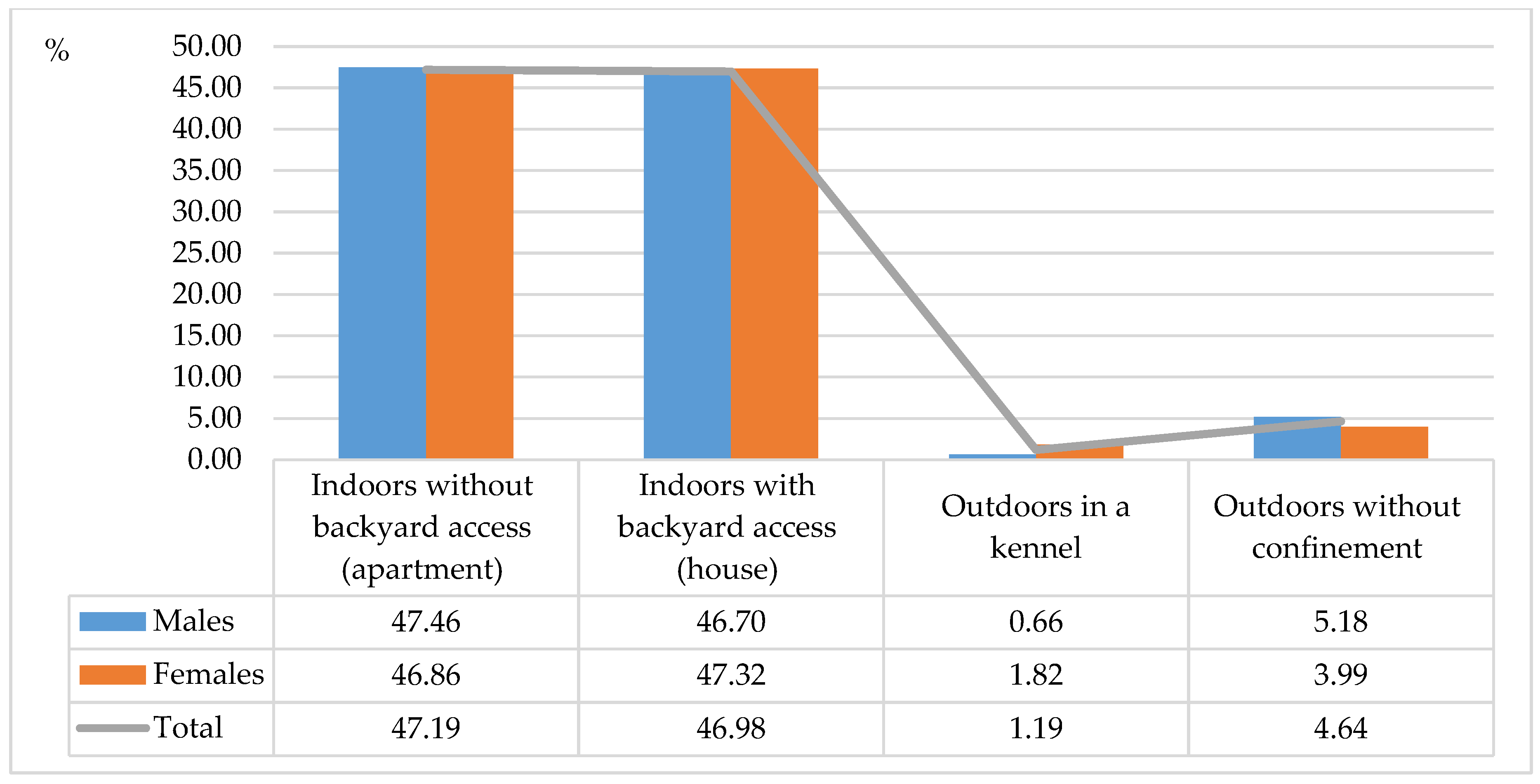
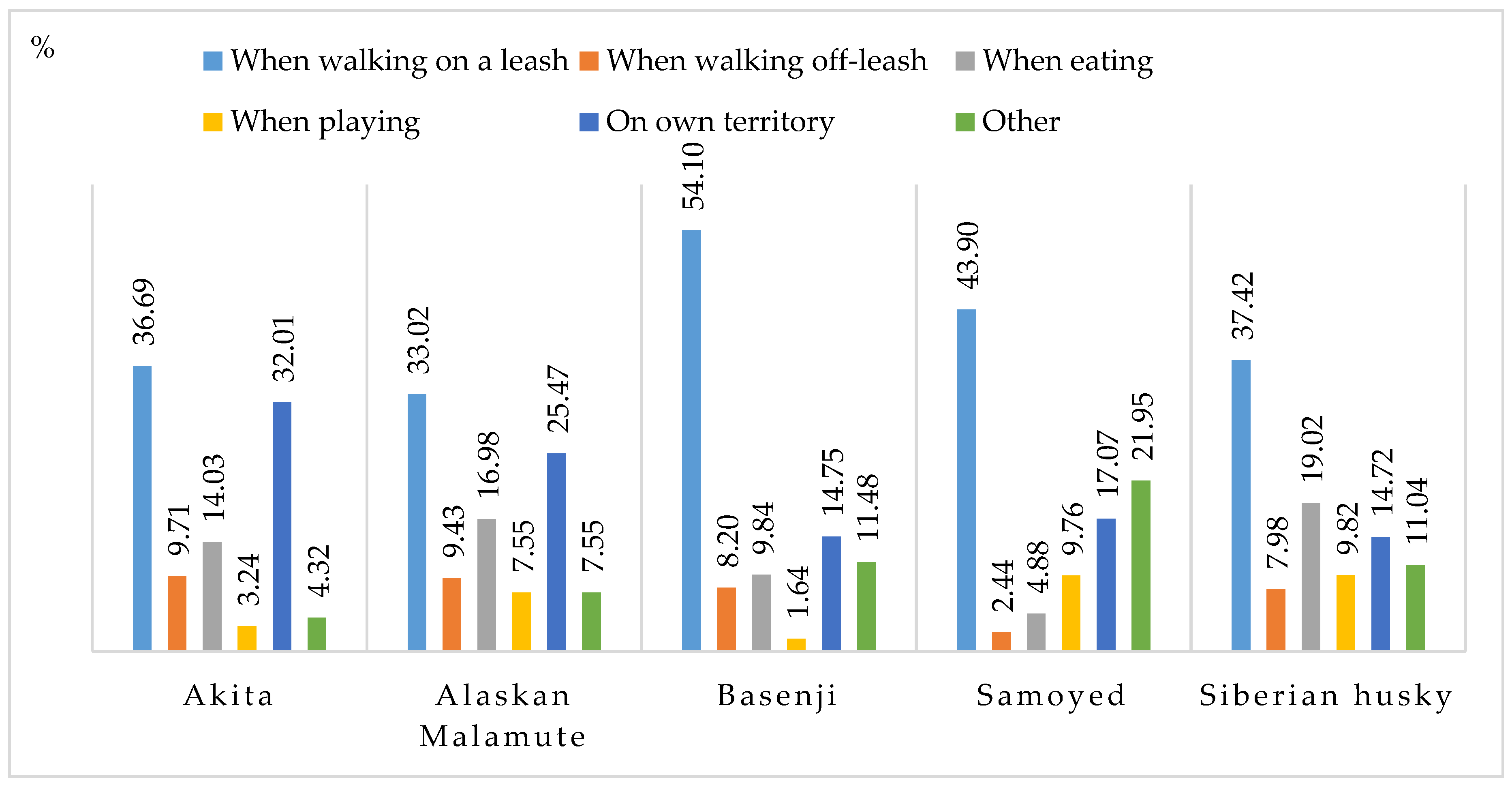
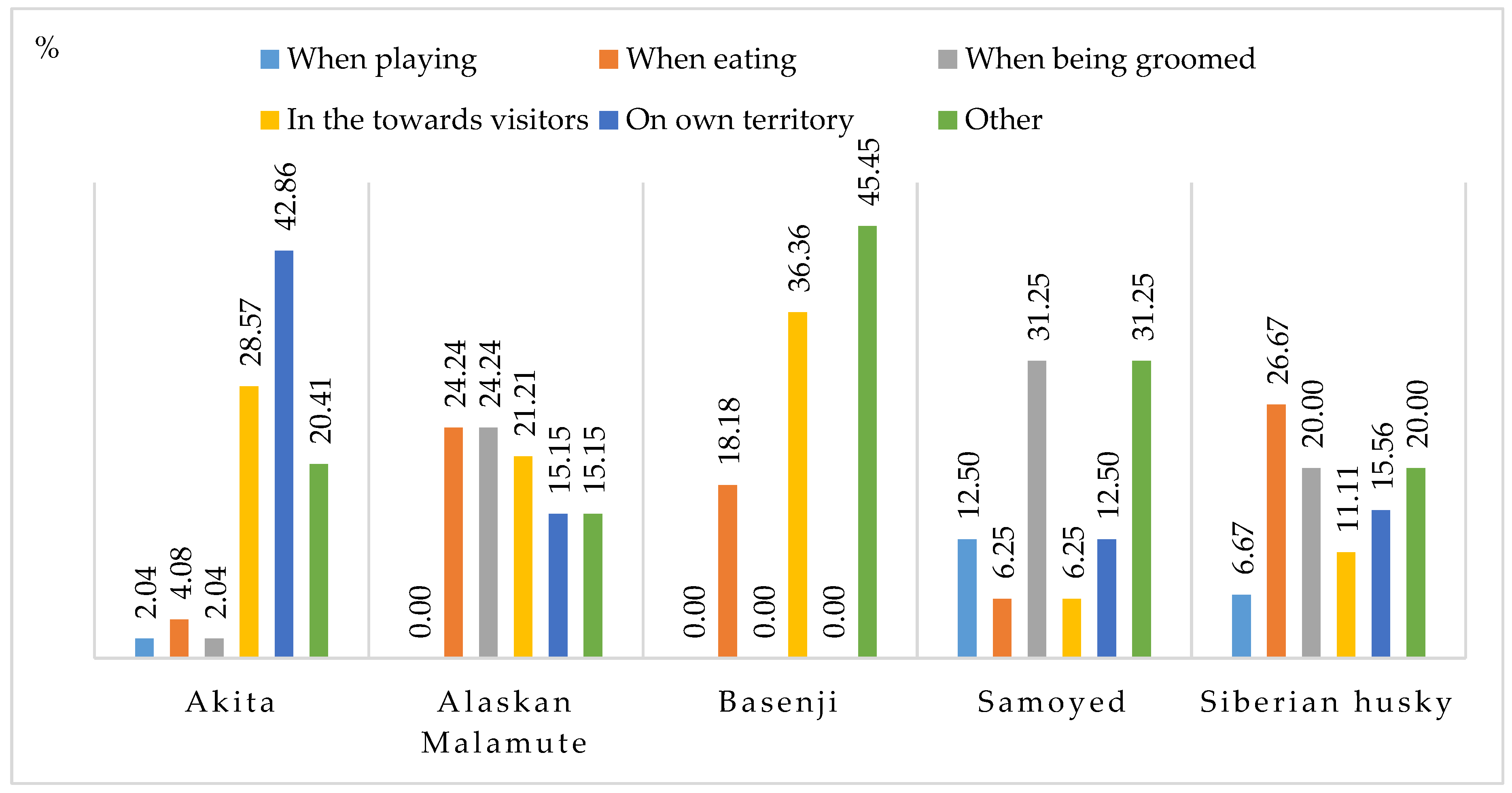


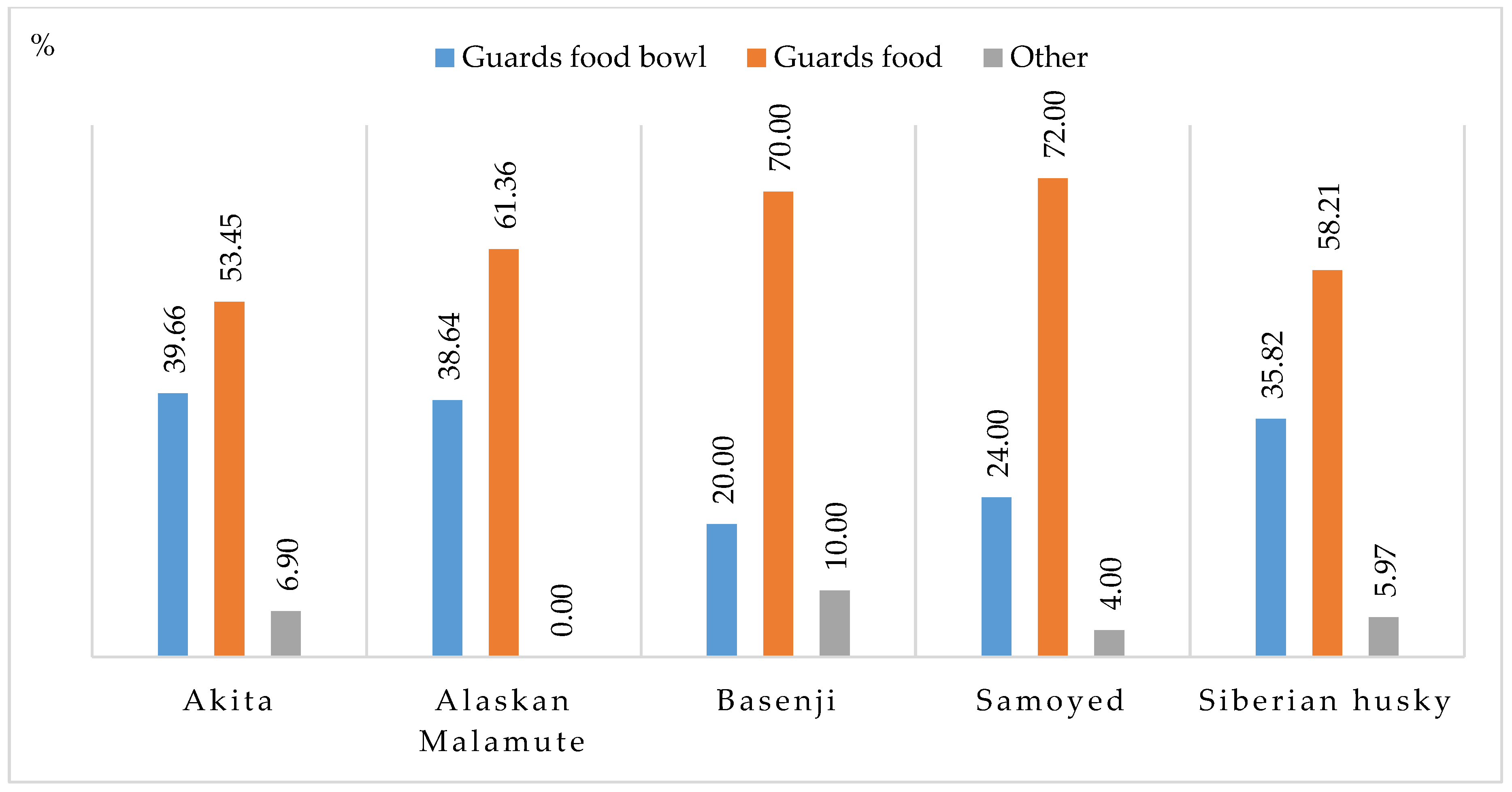
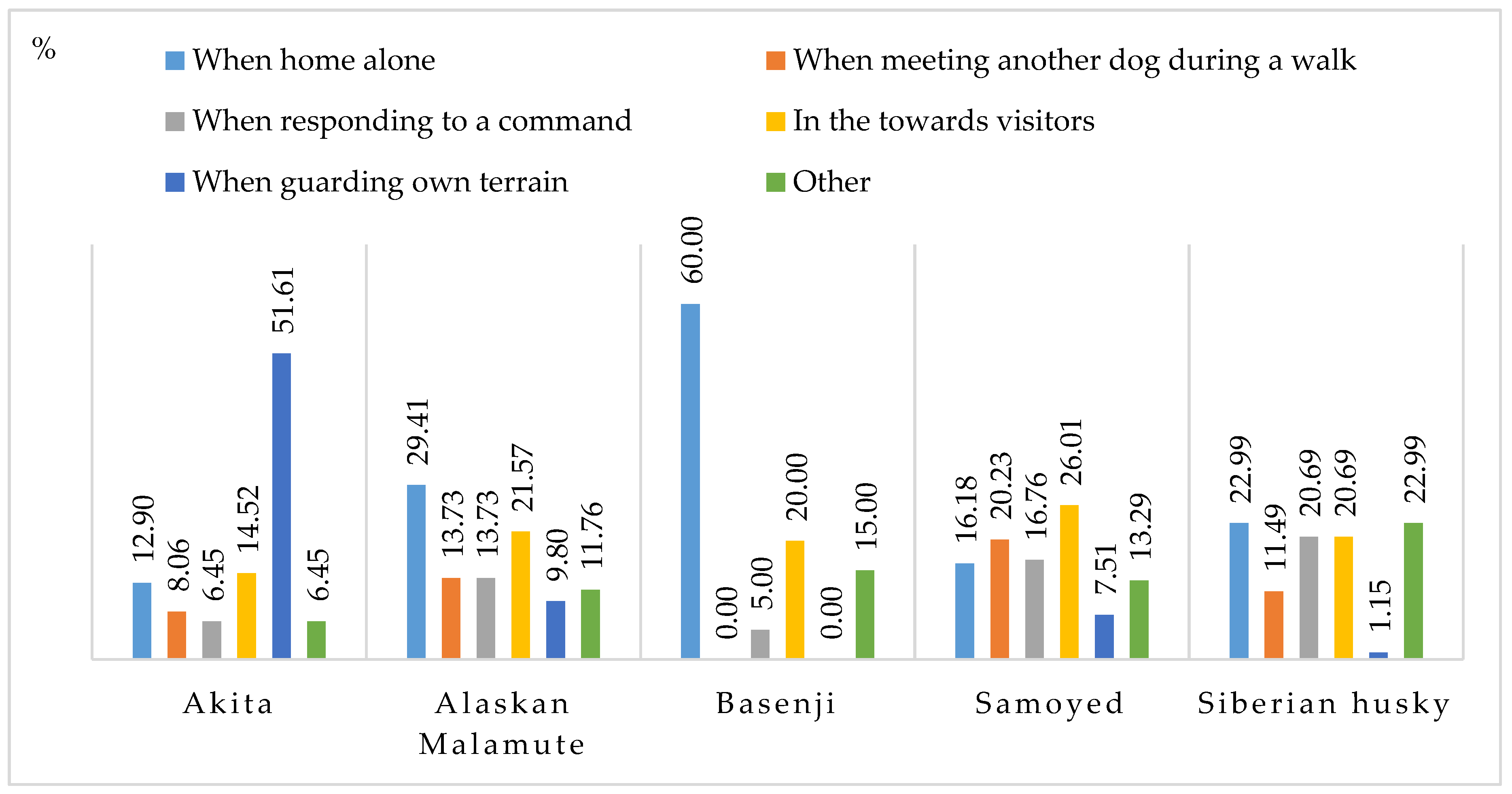
| Undesirable Behavior (Yes/No) | Description of Undesirable Behavior (the Respondents Could Select Multiple Answers) |
|---|---|
| Aggression towards other dogs/animals | - When walking on a leash - When walking off-leash - When eating - When playing - On own territory - Other |
| Aggression towards humans | - When playing - When eating - When being groomed - Towards visitors - On own territory - Other |
| Aggression at mealtime | - Guards food bowl - Guards food - Other |
| Separation anxiety | - Vocalizes - Eliminates in the house - Damages furniture and other objects - Scratches doors and windows - Other |
| Oral and locomotion behaviors | - Chews leg or other body parts - Self-licks excessively - Chases own tail - Runs along the fence line - Chases cars/bicycles - Other |
| Excessive vocalization | - When home alone - When meeting another dog during a walk - When responding to a command - Towards visitors - When guarding own terrain- Other |
| Behavior Problem | Akita (n = 253) | Alaskan Malamute (n = 116) | Basenji (n = 64) | Samoyed (n = 218) | Siberian Husky (n = 246) | χ2 | p | ||||||
|---|---|---|---|---|---|---|---|---|---|---|---|---|---|
| Yes | No | Yes | No | Yes | No | Yes | No | Yes | No | ||||
| Aggression towards other dogs/animals | n | 149 | 104 | 54 | 62 | 35 | 29 | 25 | 193 | 86 | 160 | 122.739 | 0.001 |
| % | 58.89 | 41.11 | 46.55 | 53.45 | 54.69 | 45.31 | 11.47 | 88.53 | 34.96 | 65.04 | |||
| Aggression towards humans | n | 33 | 220 | 20 | 96 | 6 | 58 | 12 | 206 | 25 | 221 | 12.997 | 0.011 |
| % | 13.04 | 86.96 | 17.24 | 82.76 | 9.38 | 90.63 | 5.50 | 94.50 | 10.16 | 89.84 | |||
| Aggression at mealtime | n | 43 | 210 | 34 | 82 | 10 | 54 | 20 | 198 | 50 | 196 | 23.231 | 0.001 |
| % | 17.00 | 83.00 | 29.31 | 70.69 | 15.63 | 84.38 | 9.17 | 90.83 | 20.33 | 79.67 | |||
| Separation anxiety | n | 25 | 228 | 18 | 98 | 11 | 53 | 39 | 179 | 32 | 214 | 7.292 | 0.121 |
| % | 9.88 | 90.12 | 15.52 | 84.48 | 17.19 | 82.81 | 17.89 | 82.11 | 13.01 | 86.99 | |||
| Oral and locomotion behaviors | n | 69 | 184 | 27 | 89 | 14 | 50 | 64 | 154 | 44 | 202 | 10.018 | 0.040 |
| % | 27.27 | 72.73 | 23.28 | 76.72 | 21.88 | 78.13 | 29.36 | 70.64 | 17.89 | 82.11 | |||
| Excessive vocalization | n | 44 | 209 | 31 | 85 | 15 | 49 | 96 | 122 | 60 | 186 | 44.699 | 0.001 |
| % | 17.39 | 82.61 | 26.72 | 73.28 | 23.44 | 76.56 | 44.04 | 55.96 | 24.39 | 75.61 | |||
| Behavior Problem | Males (n= 460) | Females (n = 437) | χ2 | p | |||
|---|---|---|---|---|---|---|---|
| Yes | No | Yes | No | ||||
| Aggression towards other dogs/animals | n | 195 | 264 | 154 | 283 | 4.821 | 0.028 |
| % | 57.61 | 42.39 | 64.76 | 35.24 | |||
| Aggression towards humans | n | 56 | 404 | 40 | 397 | 2.140 | 0.144 |
| % | 12.17 | 87.83 | 9.15 | 90.85 | |||
| Aggression at mealtime | n | 76 | 384 | 81 | 356 | 0.629 | 0.428 |
| % | 16.52 | 83.48 | 18.54 | 81.46 | |||
| Separation anxiety | n | 59 | 401 | 66 | 371 | 0.969 | 0.325 |
| % | 12.83 | 87.17 | 15.10 | 84.90 | |||
| Oral and locomotion behaviors | n | 123 | 337 | 95 | 342 | 3.045 | 0.081 |
| % | 26.74 | 73.26 | 21.74 | 78.26 | |||
| Excessive vocalization | n | 126 | 334 | 120 | 317 | 0.0005 | 0.982 |
| % | 27.39 | 72.61 | 27.46 | 72.54 | |||
| Behavior Problem | Kennel Registered with the Polish Kennel Club (n = 582) | Private Owner (n = 21) | Unregistered Kennel (n = 111) | Foundation (n = 92) | Shelter (n = 74) | Origin Unknown (n = 17) | χ2 | p | |||||||
|---|---|---|---|---|---|---|---|---|---|---|---|---|---|---|---|
| Yes | No | Yes | No | Yes | No | Yes | No | Yes | No | Yes | No | ||||
| Aggression towards other dogs/animals | n | 215 | 367 | 12 | 9 | 51 | 60 | 38 | 54 | 28 | 46 | 5 | 12 | 7.100 | 0.213 |
| % | 36.94 | 63.06 | 57.14 | 42.86 | 45.95 | 54.05 | 41.30 | 58.70 | 37.84 | 62.16 | 29.41 | 70.59 | |||
| Aggression towards humans | n | 52 | 530 | 4 | 17 | 17 | 94 | 12 | 80 | 10 | 64 | 1 | 16 | 7.457 | 0.189 |
| % | 8.93 | 91.07 | 19.05 | 80.95 | 15.32 | 84.68 | 13.04 | 86.96 | 13.51 | 86.49 | 5.88 | 94.12 | |||
| Aggression at mealtime | n | 92 | 490 | 6 | 15 | 26 | 85 | 15 | 77 | 16 | 58 | 2 | 15 | 6.983 | 0.222 |
| % | 15.81 | 84.19 | 28.57 | 71.43 | 23.42 | 76.58 | 16.30 | 83.70 | 21.62 | 78.38 | 11.76 | 88.24 | |||
| Separation anxiety | n | 82 | 500 | 5 | 16 | 17 | 94 | 6 | 86 | 11 | 63 | 4 | 13 | 7.469 | 0.188 |
| % | 14.09 | 85.91 | 23.81 | 76.19 | 15.32 | 84.68 | 6.52 | 93.48 | 14.86 | 85.14 | 23.53 | 76.47 | |||
| Oral and locomotion behaviors | n | 157 | 425 | 4 | 17 | 20 | 91 | 15 | 77 | 20 | 54 | 2 | 15 | 9.910 | 0.078 |
| % | 26.98 | 73.02 | 19.05 | 80.95 | 18.02 | 81.98 | 16.30 | 83.70 | 27.03 | 72.97 | 11.76 | 88.24 | |||
| Excessive vocalization | n | 164 | 418 | 5 | 16 | 29 | 82 | 26 | 66 | 17 | 57 | 5 | 12 | 1.201 | 0.945 |
| % | 28.18 | 71.82 | 23.81 | 76.19 | 26.13 | 73.87 | 28.26 | 71.74 | 22.97 | 77.03 | 29.41 | 70.59 | |||
| Behavior Problem | Indoors without Backyard Access (Apartment) (n = 147) | Indoors with Backyard Access (House) (n = 487) | Outdoors in a Kennel (n = 120) | Outdoors without Confinement (n = 69) | Outdoors with Confinement (n = 33) | Other (n = 41) | χ2 | p | |||||||
|---|---|---|---|---|---|---|---|---|---|---|---|---|---|---|---|
| Yes | No | Yes | No | Yes | No | Yes | No | Yes | No | Yes | No | ||||
| Aggression towards other dogs/animals | n | 52 | 95 | 187 | 300 | 48 | 72 | 32 | 37 | 15 | 18 | 15 | 26 | 3.193 | 0.670 |
| % | 35.37 | 34.63 | 38.40 | 61.60 | 40.00 | 60.00 | 46.38 | 53.62 | 45.45 | 54.55 | 36.59 | 63.41 | |||
| Aggression towards humans | n | 11 | 136 | 51 | 436 | 12 | 108 | 11 | 58 | 4 | 29 | 7 | 34 | 5.476 | 0.361 |
| % | 7.48 | 92.52 | 10.47 | 89.53 | 10.00 | 90.00 | 15.94 | 84.06 | 12.12 | 87.88 | 17.07 | 82.93 | |||
| Aggression at mealtime | n | 27 | 120 | 86 | 401 | 24 | 96 | 11 | 58 | 4 | 29 | 5 | 36 | 2.181 | 0.824 |
| % | 18.37 | 81.63 | 17.66 | 82.34 | 20.00 | 80.00 | 15.94 | 84.06 | 12.12 | 87.88 | 12.20 | 87.80 | |||
| Separation anxiety | n | 24 | 123 | 64 | 423 | 13 | 107 | 14 | 55 | 6 | 27 | 4 | 37 | 5.336 | 0.376 |
| % | 16.33 | 83.67 | 13.14 | 86.86 | 10.83 | 89.17 | 20.29 | 79.71 | 18.18 | 81.82 | 9.76 | 90.24 | |||
| Oral and locomotion behaviors | n | 30 | 117 | 122 | 365 | 31 | 89 | 21 | 48 | 5 | 28 | 9 | 32 | 4.549 | 0.474 |
| % | 20.41 | 79.59 | 25.05 | 74.95 | 25.83 | 74.17 | 30.43 | 69.57 | 15.15 | 84.85 | 21.95 | 78.05 | |||
| Excessive vocalization | n | 38 | 109 | 141 | 346 | 27 | 93 | 18 | 51 | 10 | 23 | 12 | 29 | 2.486 | 0.779 |
| % | 25.85 | 74.15 | 28.95 | 71.05 | 22.50 | 77.50 | 26.09 | 73.91 | 30.30 | 69.70 | 29.27 | 70.73 | |||
| Behavior Problem | Indoors without Backyard Access (Apartment) (n = 422) | Indoors with Backyard Access (House) (n = 422) | Outdoors in a Kennel (n = 14) | Outdoors without Confinement (n = 39) | χ2 | p | |||||
|---|---|---|---|---|---|---|---|---|---|---|---|
| Yes | No | Yes | No | Yes | No | Yes | No | ||||
| Aggression towards other dogs/animals | n | 143 | 279 | 183 | 239 | 2 | 12 | 21 | 18 | 15.236 | 0.002 |
| % | 33.89 | 66.11 | 43.36 | 56.64 | 14.29 | 85.71 | 53.85 | 46.15 | |||
| Aggression towards humans | n | 38 | 384 | 52 | 370 | 1 | 13 | 5 | 34 | 2.800 | 0.424 |
| % | 9.00 | 91.00 | 12.32 | 87.68 | 7.14 | 92.86 | 12.82 | 87.18 | |||
| Aggression at mealtime | n | 58 | 364 | 90 | 332 | 2 | 12 | 7 | 32 | 8.509 | 0.037 |
| % | 13.74 | 86.26 | 21.33 | 78.67 | 14.29 | 85.71 | 17.95 | 82.05 | |||
| Separation anxiety | n | 61 | 361 | 51 | 371 | 4 | 10 | 9 | 30 | 6.517 | 0.089 |
| % | 14.45 | 85.55 | 12.09 | 87.91 | 28.57 | 71.73 | 23.08 | 76.92 | |||
| Oral and locomotion behaviors | n | 108 | 314 | 98 | 324 | 4 | 10 | 8 | 31 | 1.092 | 0.779 |
| % | 25.59 | 74.41 | 23.22 | 76.78 | 28.57 | 71.43 | 20.51 | 79.49 | |||
| Excessive vocalization | n | 135 | 287 | 96 | 326 | 5 | 9 | 10 | 29 | 9.601 | 0.022 |
| % | 31.71 | 68.01 | 22.75 | 77.25 | 35.71 | 64.29 | 25.64 | 74.36 | |||
Publisher’s Note: MDPI stays neutral with regard to jurisdictional claims in published maps and institutional affiliations. |
© 2021 by the authors. Licensee MDPI, Basel, Switzerland. This article is an open access article distributed under the terms and conditions of the Creative Commons Attribution (CC BY) license (https://creativecommons.org/licenses/by/4.0/).
Share and Cite
Wójcik, A.; Powierża, K. The Influence of Breed, Sex, Origin and Housing Conditions on Undesirable Behaviors in Ancient Dog Breeds. Animals 2021, 11, 1435. https://doi.org/10.3390/ani11051435
Wójcik A, Powierża K. The Influence of Breed, Sex, Origin and Housing Conditions on Undesirable Behaviors in Ancient Dog Breeds. Animals. 2021; 11(5):1435. https://doi.org/10.3390/ani11051435
Chicago/Turabian StyleWójcik, Anna, and Kinga Powierża. 2021. "The Influence of Breed, Sex, Origin and Housing Conditions on Undesirable Behaviors in Ancient Dog Breeds" Animals 11, no. 5: 1435. https://doi.org/10.3390/ani11051435
APA StyleWójcik, A., & Powierża, K. (2021). The Influence of Breed, Sex, Origin and Housing Conditions on Undesirable Behaviors in Ancient Dog Breeds. Animals, 11(5), 1435. https://doi.org/10.3390/ani11051435




